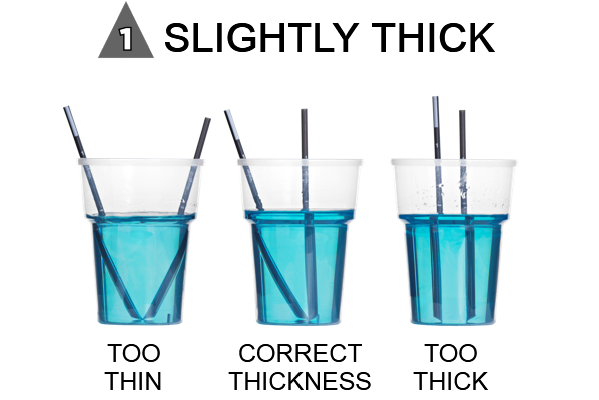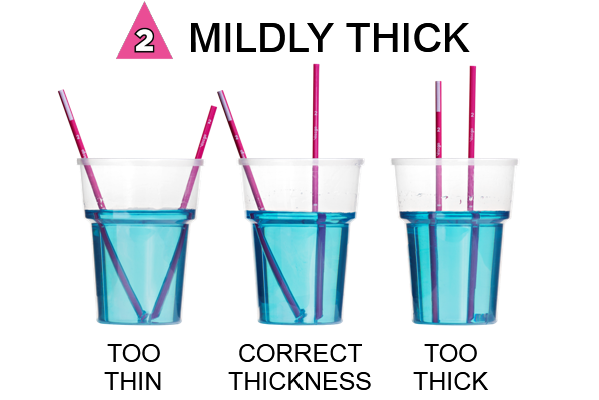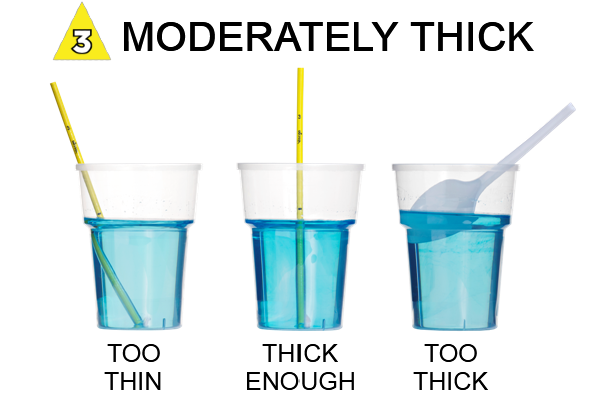Quick Easy Practical Drink Thickness Test
In this article we’ll introduce you to Viscgo’s quick, easy, practical drink thickness test, compare it to the IDDSI Flow Test and briefly explain what dysphagia is, why you need to thicken drinks and why you need to test that a drink is the correct thickness.
Viscgo drink thickness test
Like all the best solutions, the Viscgo drink thickness test is really very simple. It’s based on the fact that a stick placed upright in a liquid will either stand (for a while) or fall depending on the thickness of the liquid and the dimensions and mass of the stick.
Each Viscgo drink thickness test stick is designed to fall within 10 seconds if a drink is below a certain level of thickness and stand for at least 10 seconds if a drink is above a certain level of thickness.
The Viscgo drink thickness test for xanthan gum-based thickeners doesn’t require much skill or dexterity and takes just 10 seconds.
The Viscgo sticks have been calibrated against standardised liquids matching the IDDSI Framework, verified by Associate Professor Ben Hanson of University College London.
We explain how the Viscgo sticks work in more detail here and full instructions are given here.
You can watch a short video demonstration of the Sticks here.
For more information on our range of drink thickness test products, click the links below:
Assessment Kit, Level 1 Test Kit, Level 2 Test Kit, Level 3 Test Kit, Viscgo Sticks.
The IDDSI flow test
Of course, the IDDSI flow test can be used to evaluate the thickness of a drink in relation to the IDDSI Framework.
But, compared to the Viscgo sticks, the IDDSI flow test is quite “fiddly” and requires a high degree of accuracy regarding volume of liquid and timing. It also requires a level of dexterity that not everyone will have. It’s more of a training aid than a practical way to test every drink.
We explain the problems, issues and limitations of this drink thickness test in more detail in our article on the IDDSI syringe test (as it is also known).
A brief introduction to dysphagia
Dysphagia is difficulty swallowing. It is usually caused by nerve or structural damage, a disease or an acquired disorder that affects the swallow.
Acquired neurological conditions such as stroke and degenerative diseases such as dementia are common causes of dysphagia. So it is prevalent among the elderly, although it can affect people of any age. It is estimated that 8% of people have dysphagia.
Dysphagia can cause pain, heartburn, hoarseness, coughing, regurgitation, a sensation of food stuck in the throat or chest, choking, drooling, loss of appetite, food refusal, weight-loss, malnutrition, dehydration, aspiration, pneumonia and death.
More information is given in our article What Is Dysphagia?
Why you need to thicken drinks
Dysphagia can cause aspiration which is where food or drink goes down the trachea (“windpipe”) into the lungs rather than down the oesophagus (“foodpipe”) into the stomach. This is unpleasant and can cause choking. Over time, it can cause pneumonia which can be fatal.
An effective dysphagia treatment and management method is to thicken drinks with powdered starch or gum. This makes the drink more cohesive or “sticky” so when swallowed, it is less likely that some will be aspirated.
Although thickening drinks can reduce the risk of aspiration, it’s important not to make drinks thicker than necessary for several reasons:
- If a drink is too thick, some may remain in the throat after the swallow which may cause choking or may be aspirated.
- Many people dislike the consistency of thick drinks which might lead to them drinking less and becoming dehydrated.
- The thickener can also slow down or reduce the digestion of some medicines.
Different people with dysphagia can cope with drinks of different thicknesses. So it’s important to provide drinks that are not too thin and not too thick for each person.
Why you need to test that a drink is the correct thickness: TIME, TEMPERATURE and TYPE of drink
Although thickening drinks is a common dysphagia treatment and management approach, there are problems with thickened drinks.
The manufacturers of thickening powders provide information on their packaging about how much of their product should be added to a drink to achieve a particular consistency. But this is only a guide because, as we explain in why test the thickness of a drink, different amounts of thickener are required for different TYPES of drinks and drinks at different TEMPERATURES.
Chilled milk, orange juice at room temperature and hot coffee will need different amounts of thickener to reach the same consistency.
The consistency of a thickened drink can also alter over TIME for several reasons.
It may take several minutes for a drink to reach the correct thickness after thickener has been added. So the drink may be too thin if it is drunk too soon.
Also, some thickeners, particularly those made from starch, continue to slowly thicken a drink over time. So if a drink isn’t drunk soon after it has been thickened, it may become too thick.
Another problem with starch-based thickeners is that an enzyme in saliva called amylase breaks down starch. This can lead to a drink that is drunk slowly over time becoming too thin.
And because the consistency of a thickened drink is affected by it’s temperature, a chilled drink will become thinner as it warms up and a hot drink will become thicker as it cools down.
Drinks can also be thickened incorrectly due to mistakes. If the thickening powder isn’t thoroughly mixed into the drink, some can clump together into lumps which means the drink will be too thin.




